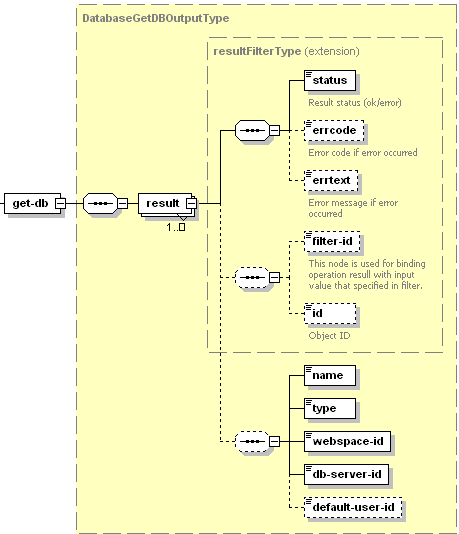Retrieving Information About Databases
Use the get-db operation to retrieve the following database preferences:
- Name
- Type
- Subscription ID
- Database server ID
- Default database user ID
Request Packet Structure
A request XML packet retrieving database parameters includes the get-db operation node:
<packet>
<database>
<get-db>
...
</get-db>
</database>
</packet>
The get-db node is presented by type DatabaseGetDBInputType
(database_input.xsd), and its graphical representation is as
follows:

Note: The interactive schema navigator for all request packets is available here: http://plesk.github.io/api-schemas/1.6.9.1/agent_input.svg.
- The filter node is required. Specifies the filtering rule. For
more information, refer to the Available Filters
section. Data type: DatabaseFilterType
(
database_input.xsd) .
Remarks
You can retrieve information on multiple databases using a single packet. Add as many get-db operations as the number of different filtering rules (you can either filter by ID, webspace-id, or by webspace-name).
<database>
<get-db>
<filter>
...
</filter>
</get-db>
</database>
Response Packet Structure
The get-db node of the output XML packet is presented by type
DatabaseGetDBOutputType (database_output.xsd) and structured as
follows:

Note: The interactive schema navigator for all response packets is available here: http://plesk.github.io/api-schemas/1.6.9.1/agent_output.svg.
- The result node is required. It wraps the response retrieved
from the server. Data type: resultType (
common.xsd). - The status node is required. It specifies the execution status of the get-db operation. Data type: string. Allowed values: ok | error.
- The errcode node is optional. Is returns the error code if the get-db operation fails. Data type: integer.
- The errtext node is optional. It returns the error message if the get-db operation fails. Data type: string.
- The filter-id node is optional. It returns the filtering rule parameter. For more information, refer to the Available Filters section.
- The name node is required. It specifies the database name. Data type: string.
- The type node is required. It specifies the database type. MySQL and Microsoft SQL Server are available in Plesk for Windows. MySQL and PostgreSQL types are available in Plesk for Unix. Data type: string. Allowed values: mssql | mysql | postgresql.
- The webspace-id node is optional. It is required if the get-db operation succeeds. It specifies the ID of the subscription on which a database is added. Data type: integer.
- The db-server-id node is optional. It is required if the get-db operation succeeds. It specifies the ID of the database server on which a database will be created. This node is required only in Plesk for Linux. Data type: integer.
- The default-user-id node is optional. It is required if the get-db operation succeeds. It specifies the ID of the default database user. Data type: integer.
Retrieving database parameters
This packet retrieves information on a database with ID 5.
<packet>
<database>
<get-db>
<filter>
<id>5</id>
</filter>
</get-db>
</database>
</packet>
Response:
<packet>
<database>
<get-db>
<result>
<status>ok</status>
<filter-id>5</filter-id>
<id>5</id>
<name>MyDatabase</name>
<type>mysql</type>
<webspace-id>77</webspace-id>
<db-server-id>17</db-server-id>
<default-user-id>10</default-user-id>
</result>
</get-db>
</database>
</packet>
Retrieving parameters of multiple databases
This packet retrieves information on all databases added to the MyDomain.com, My2Domain.com subscriptions and to the subscription specified by ID 45.
<packet>
<database>
<get-db>
<filter>
<webspace-name>MyDomain.com</webspace-name>
<webspace-name>My2Domain.com</webspace-name>
</filter>
</get-db>
<get-db>
<filter>
<webspace-id>45</webspace-id>
</filter>
</get-db>
</database>
</packet>
Response (when one database was found on subscription MyDomain.com, the subscription with ID 45 and subscription My2Domain.com were not found):
<packet>
<database>
<get-db>
<result>
<status>ok</status>
<filter-id>MyDomain.com</filter-id>
<id>5</id>
<name>MyDatabase</name>
<type>mysql</type>
<webspace-id>77</webspace-id>
<db-server-id>17</db-server-id>
<default-user-id>10</default-user-id>
</result>
</get-db>
<get-db>
<result>
<status>error</status>
<errcode>1015</errcode>
<errtext>Domain does not exist</errtext>
<filter-id>My2Domain.com</filter-id>
</result>
<result>
<status>error</status>
<errcode>1015</errcode>
<errtext>Domain does not exist</errtext>
<filter-id>45</filter-id>
</result>
</get-db>
</database>
</packet>
Response (when two or more databases are found on the specified ):
<packet>
<database>
<get-db>
<result>
<status>ok</status>
<filter-id>MyDomain.com</filter-id>
<id>5</id>
<name>MyDatabase</name>
<type>mysql</type>
<webspace-id>77</webspace-id>
<db-server-id>17</db-server-id>
<default-user-id>10</default-user-id>
</result>
</get-db>
<get-db>
<result>
<status>ok</status>
<filter-id>MyDomain.com</filter-id>
<id>8</id>
<name>My2base</name>
<type>mysql</type>
<webspace-id>77</webspace-id>
<db-server-id>17</db-server-id>
<default-user-id>10</default-user-id>
</result>
</get-db>
</database>
</packet>